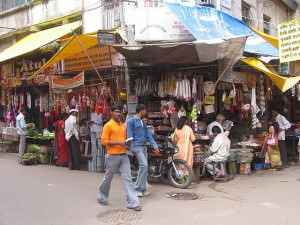Goodbye to the Local Walla? Globalization Gaining Momentum in India
By Carly Vandergriendt
I have a confession to make.
Only a ten minute walk from my house, a multiple-storey building rises out of the pavement like a beacon of hope for callous capitalists everywhere. Its glossy windows are flanked by “SALE” signs that compel urgency. The pavilion outside is peppered with the requisite shoppers, brandishing their latest purchases in gigantic bags tattooed with store logos. Around the side of the building, two- and four-wheelers roll at impressive speeds into the cavernous depths of a vast underground parking lot, before their occupants calmly ascend to the ground level…
I won’t deny it. The first time I walked through the doors of that mall, I felt more at home than I had ever felt in India. Maybe it was the over-abundant fluorescent lights, the stark lack of clocks, the universally-recognizable smell of Subway, or the frigid breath of the air conditioning against my skin. But something about that world made it instantly familiar to me, even when most of the stores were alien.
When I feel particularly homesick, I go to the mall. Perhaps I am a lost cause. I grew up in a predictable suburb of Waterloo, a medium-sized city (by Canadian standards) in the most densely-populated region of the country. Southern Ontario is like the kid brother who can never quite live up to the rampant consumer culture of the United States, but tries hard nonetheless. By the time I was 18, my hometown had become officially indistinct from every other city in North America with the grand opening of its maiden Wal-Mart on what used to be a benign cornfield less than five minutes’ drive from my parents’ house.
Since then, there is a growing undercurrent of dissatisfaction with the way these megastores are impacting our cities, communities, and livelihoods. Recent trends, including the “100 Mile Diet” and the “Farmers Feed Cities” initiative, point to the reality that big boxes are neither healthy for us, nor are they healthy for the planet. My own personal experiments at Wal-Mart have almost always led to severe buyer’s remorse. Did I really need a Pilates mat, a distressed Miley Cyrus jean shirt, a family-sized bag of barbecue chips, multivitamins to offset the nutritional value of the chips, a chintzy shower radio, or a new potted plant that isn’t likely to make it to the weekend?
It may be too late for Canada – at least in the inhabitable parts – but the same cannot be said of India. After spending nearly a year living in Jaipur, a medium-sized city (by Indian standards), I have had the privilege of witnessing the somewhat awkward, pubescent transition that this country is making as global influences kick in like adolescent hormones. [pullquote]And much like a parent in denial, I can’t help wishing that India would stay a kid forever.[/pullquote]
I panicked when I heard the Indian government’s September 14 decision to open the retail sector to multi-national grocery chains, picturing a Wal-Mart looming on every horizon like a box-shaped, football field-sized rain cloud – and I’m not talking about the monsoon. What makes this country distinct is the slightly careless amalgamation of family-owned corner pharmacies, mixed-bag dried goods stores, and dodgy electronics shops that line the streets of almost every city. What will all those enterprising little guys, a.k.a. the dhoodwalla, the sabziwalla, and the phulwalla, do when the big corporations set up shop?
Supporters of the government’s decision argue that goods will become cheaper for Indian consumers, which is one of the main reasons behind Wal-Mart’s popularity in the U.S. and Canada. This factor is going to affect the Indian population differently though, as socioeconomic classes are highly stratified. According to a class breakdown from McKinsey Global Institute, in 2005 the combined poor and lower classes made up 95% of the Indian population, while the combined middle and upper classes made up a meagre 5%. That portrait is expected to change drastically by 2015, with the latter growing to 21% – still, the majority of Indian people will subsist on less than USD $2 per day.
Luckily, the decision has come with strings attached. For instance, foreign companies will have to invest at least USD $100 million and will only be able to open stores in cities with populations greater than one million. They will also have to source 30% of their produce from India. And, states in India are being given full control over whether or not they allow multi-national companies. So states that are against the decision can feasibly opt-out.
//
//
I suppose it’s difficult to pinpoint the palpable outcome of this decision. Nonetheless, this is a pivotal time for India. Living here has opened my eyes to a retail reality that favours the local little guy instead of the multinational big-wig, and I’m observing that hastily-shifting balance. It’s like David and Goliath on a teeter-totter.
I may cherish nostalgia-laced trips to the mall every now and then, but it’s the moments that I spend exploring the texture of the streets of India that exhilarate me. I came here to feel uncomfortable. Unfortunately, the effects of globalization are so tangible that I know that the next time I return to India – whether it’s in one year, five years, or ten – I might just feel comfortable.
This article was provided courtesy of AIESEC Canada Inc. Connect with them here:
– Website: http://aiesec.ca/
– Facebook: http://www.facebook.com/AIESECCanada
– Twitter: https://twitter.com/aieseccanada
























Share the post "Goodbye to the Local Walla? Globalization Gaining Momentum in India"